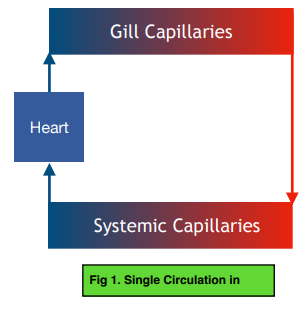Circulatory System - The Single Circulatory System (GCSE Biology)
The Single Circulatory System
The Circulatory System
The circulatory system involves three components: the heart, the vessels and the blood. The heart pumps the blood, the vessels carry the blood around the body, and the heart pumps blood around the body. The vessels carry blood around the body, and the blood contains components such as oxygen and carbon dioxide.
Single Circulatory System
A single circulatory system is when the blood only passes through the heart once in a single circuit.
This type of circulation occurs in fish.
Single Circulation in Fish
- Deoxygenated blood from the fish’s body travel to the heart.
- The heart pumps the blood around the body. This occurs is a single circuit.
- The blood is oxygenated at the gills. Water passes over the fish’s gills and oxygen diffuses into the blood.

The circulatory system is a network of organs and tissues that help distribute oxygen, nutrients, hormones, and other substances to the cells in the body and remove waste products. The circulatory system consists of the heart, blood vessels, and blood.
A single circulatory system is a type of circulatory system in which blood only flows through the body once. This type of circulatory system is found in simple animals such as invertebrates, fish, and amphibians. In these animals, the circulatory system is not divided into separate systems for oxygenated and deoxygenated blood.
The single circulatory system works by pumping blood from the heart to the rest of the body through blood vessels. The blood carries oxygen and nutrients to the cells and tissues and picks up waste products, which are then transported back to the heart. The heart pumps the blood to the gills, where it is oxygenated, and then circulates the oxygenated blood through the rest of the body.
The components of the single circulatory system include the heart, blood vessels, and blood. The heart acts as the pump and pumps blood through the vessels, which carry the blood to the cells and tissues. The blood carries oxygen, nutrients, hormones, and other substances to the cells and removes waste products.
The single circulatory system is different from the double circulatory system in that blood only flows through the body once in the single circulatory system, while in the double circulatory system, blood flows through the body twice. The double circulatory system is found in mammals and birds and is divided into two separate circuits: the pulmonary circuit and the systemic circuit. In the double circulatory system, the heart pumps oxygenated blood to the rest of the body and deoxygenated blood to the lungs.
The single circulatory system supports the needs of the body by distributing oxygen, nutrients, hormones, and other substances to the cells and removing waste products. This helps to maintain a healthy and functioning body by providing cells and tissues with the necessary resources and removing harmful waste products.
The single circulatory system is important because it helps to distribute oxygen, nutrients, hormones, and other substances to the cells and tissues and remove waste products. This helps to maintain a healthy and functioning body by providing cells and tissues with the necessary resources and removing harmful waste products. In addition, the single circulatory system helps to regulate the internal environment of the body, maintain blood pressure, and support organ function.





Still got a question? Leave a comment
Leave a comment